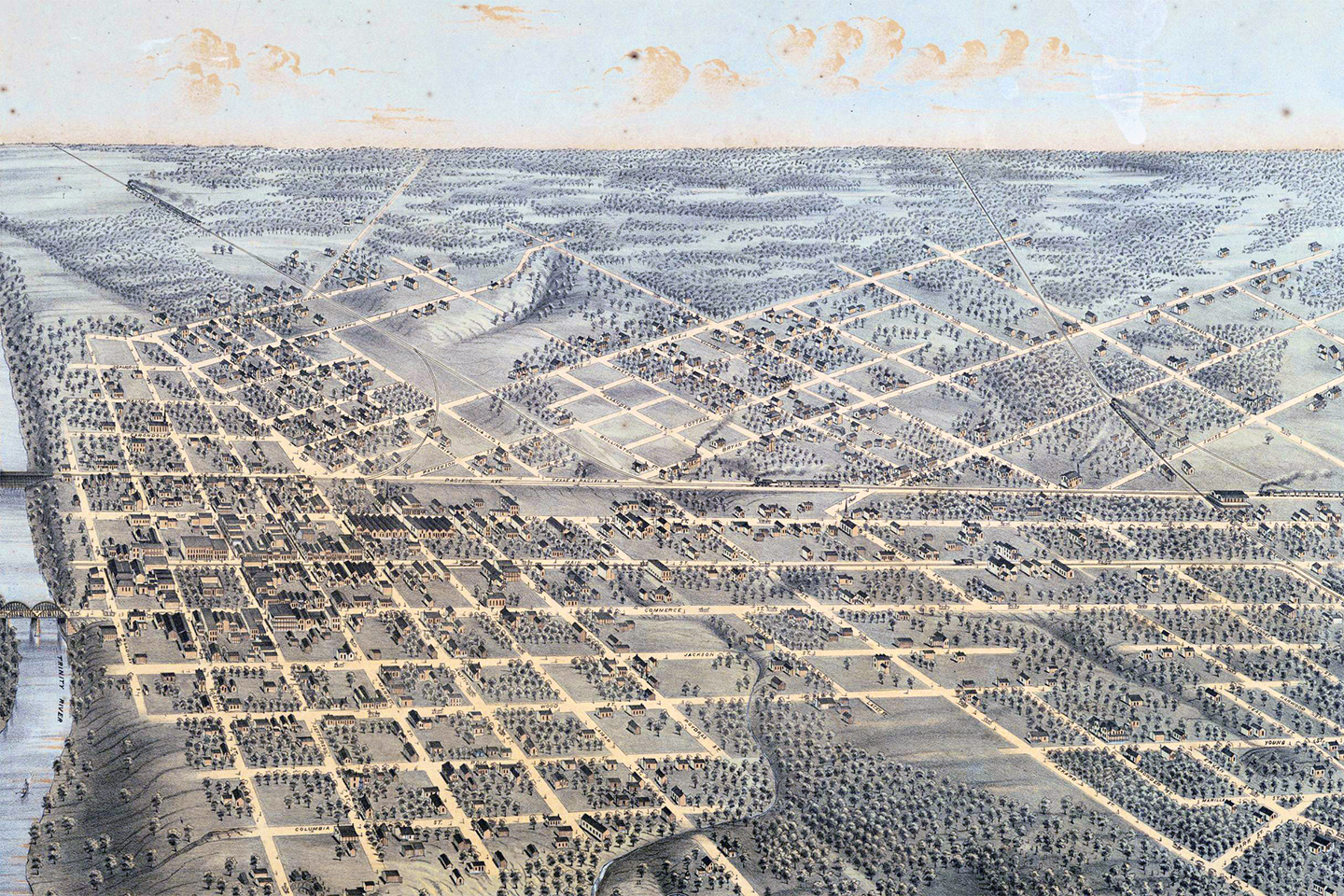Various Excerpts from Memorial and Biographical History of Dallas County, Texas
Excerpts from Memorial and Biographical History of Dallas County, Texas
Lewis Publishing Company, 1892

The following is a series of excerpts from the book Memorial and Biographical History of Dallas County, Texas, published in 1892 by the Lewis Publishing Company. The excerpts present genealogical information about several of the settlers who migrated from Bird's Fort, along with Bird's Fort settler William H. Beeman's oral reminiscences as presented on July 14, 1875 at a Dallas Pioneer Association reunion in Garland, TX.
Entry for Mabel Gilbert, p. 157
Gilbert, Mabel, and wife Martha, came from Bird's Fort, in March, 1842, Mrs. Gilbert being the first white lady to reach Dallas, though followed on the 4th of April by Mrs. John Beeman, yet living, and her daughter. Mr. Gilbert had formerly been a steamboat commander.
Entry for Thomas Rattan, p. 166
Rattan, Thomas, and family, came from Illinois in 1841; settled in Collin. Of his children, Hamp, then of Bird's Fort, was killed by Indians, one and one-half miles southwest of Carrollton, Dallas county, Christmas day, 1841; Littleton; John died in Collin; Mary married William Fitzhugh; Harriet married Andrew J. Witt, and died in Dallas; Ann married James W. Throckmorton; Hugh married a daughter of David Turner; Jennie married Mr. Moore, and died in Collin; Tollie married Robert Dowell, and lives in Collin; Edward married Miss Stiff, and lives in Collin; Louisa married Hogan Witt (cousin in Preston), of Collin; Temperance married John Kincaid; Thomas lives near Van Alstyne.
Entry for Alexander W. Webb, p. 168
Webb, Alexander W., from Illinois to Bowie county in 1840; to Bird's Fort in 1841; escaped when the Indians killed Rattan; settled with his family in Dallas county in 1842.
Entry for William H. Beeman's Recollections, pp. 178-180
Mr. W. H. Beeman, while a quiet and retired old gentleman, was one of the most interesting of the old pioneers attending the reunion at Garland. He came to Texas from Illinois with his father in 1840, and settled in what is now Dallas county in 1842. Mr. Beeman was the first to break the sod for agricultural pursuits in the county, in the spring of 1842. It was a plat of seven or eight acres about four miles east of the city of Dallas. At the same time he erected the second house built in Dallas county, the first being a log structure put up by John Neely Bryan, the founder of Dallas, a few weeks before, whose cabin stood, Mr. Beeman says, at the foot of Main street. Speaking of early life in Dallas county, Mr. Beeman said to a News reporter: "We lived very hard at first. We had wild meats and bread. I dressed the buckskins and made my moccasins and clothes, except shirts, for three years. We finger-picked cotton which the women used in weaving clothes and shirts for the men. For two years we beat our meal for bread on a mortar or ground it in a hand mill. We bad to buy corn in Fannin county. I rode in the first wagon and cut the road as we went into Dallas. We came in after cedar timber, which we cut to build a fence around Hamp Rattan's grave. Rattan, who was a brother-in-law of Governor Throckmorton, was killed by the Indians on Elm Fork while out bear hunting. He was buried twenty miles west of Dallas, at Bird's fort, but nobody knows to-day where his grave is."
Although Mr. Beeman was one of the most active participants in the organization of the county and has been a constant resident of the county, he has never held and never sought office. "When the county was organized in 1846," he said, "I went and got the order from the county court of Robertson county at Franklin. I rode a mustang and went alone. It was an Indian country then, and the trip was attended with considerable risk. I camped out each night. When I was returning home one night on the other side of Richland creek, I saw a herd of buffaloes. A storm approached that night and the buffaloes gathered in a great herd, which became wild with fright, and I could not tell the roar of the storm from the sound of the moving buffaloes. I sought protection in a skirt of timber close by.
"I assisted in building the first ferryboat that was ever put in the Trinity at Dallas. We took two large cottonwood logs, and after digging them out like canoes, we fastened them together with puncheon. This was the floor. We had no rope; buffalo rawhide stretched so that we could not use it, so we took buffalo hair and twisted it into a rope with which we towed the boat. The boat was located at what is now the foot of Commerce street bridge, and we carried across the river in it all the early settlers of the county.
"The Indians used to give us a great deal of trouble. When we came to Dallas county we left our teams of horses at Honey Grove, fearing the Indians would get them if we brought them farther. We drove oxen from Honey Grove to Dallas. Once the Indians made a raid just across the river from Dallas and stole about eighteen head of horses. A party of nineteen of us followed them to Wise county, and there we lost track of them among the friendly Indians. When we started home we ran out of provisions and bought some meat from the Indians. It was said to be horse meat, but it tasted good to a half starved man. We traveled the next day without anything to eat, and that night I shot a wild turkey on Denton creek. Nineteen men fed on it and we got up hungry. When we struck Elm fork I killed a deer, which we roasted and ate without salt or bread; but, fortunately for us, we reached home the next night.
"We lived peaceably and enjoyed ourselves those days. We had no trouble. Everybody was honest. I remember the first case of stealing that I ever heard of in the county. A young man was driving sheep down Elm fork to Dallas. On the way down he entered a place and stole a butcher knife and comb and some other little articles. He was overtaken and the parties gave him his choice between a certain number of lashes and prosecution in the courts at Dallas. He said that he would take the lashes, but he wished a thousand rails that he had not committed the theft. That was a common expression of regret those days. To split a thousand rails was a big task. I believe if more of that kind of punishment was inflicted to-day we would have less stealing.
"I remember the burning of Dallas in 1860. I was not in town that day. The fire started on the west side of the square at Wallace Peak's drug store. While the people were at work trying to check it at that point it broke out on the east side, and then they told me it broke out here and there so fast that they could not keep up with it. There is no doubt but the negroes fired the town. They said they did, and the two white preachers, whom they said had put them up to it, were whipped and sent out of the country. Just before the fire Alex. Cockrell had built a three-story brick tavern. The building was 50 x 100 feet, and it was the largest and finest building in all North Texas. It burned. A brick wareroom on the north side of Commerce Street covers the spot where this tavern was built. I kept the first tavern in Dallas in a small house on the north side of the square. Old man Tom Crutchfield rented it, and finally he built the old Crutchfield house on the northwest corner of the square, which was burned several times. But speaking of the hanging of the three negroes for setting fire to Dallas, in 1860, when excavations were being made for the Texas & Pacific railway bridge across the Trinity at Dallas, their bones were unearthed. They were buried there after they were hanged. I remember the first legal hanging in the county. It was the first trial for murder, and the negro woman, who had split a man's head open with an ax, while he was asleep, was hanged.
"I remember when steamboats were on the Trinity. I made the trip on the Sallie Haynes from Magnolia to the mouth of East Fork. I am a firm believer in the navigation of the Trinity to Dallas. I think it can be done with the expenditure of a little money in cleaning out drifts and cutting overhanging timber, and I believe that boats can be run here six to nine months each year.
"We were subjected to many privations and many hardships in the early days. When we left home we did not know but that on our return we would find our families butchered by the Indians or that we ourselves would be shot and killed. A part of the time we were in constant dread and fear and we invited immigration. We welcomed the newcomer and divided what we had with him. We wanted him to increase our numbers and help keep back the foe."
Mr. Beeman married Miss Martha E. Dye near now what is now the town of Garland in 1851. They have eight children and a number of grandchildren. His sister Margaret, who is yet living, was the wife of John Neely Bryan.

